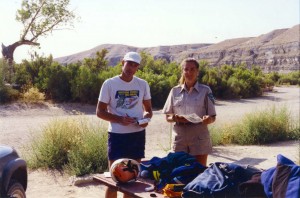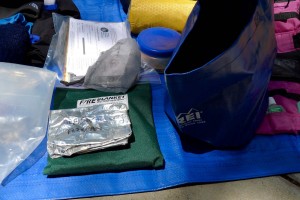The National Park Service (NPS), United States Forest Service (USFS), and Bureau of Land Management (BLM) all control river use in the American West. While each agency controlled river has its specific requirements, the following pretty much applies universally, with some exceptions or additions. Please see River Regulations (or sidebar) for partial listing of official requirements on some rivers. Necessity being the mother of invention, improvisation is often the key to satisfying some of these requirements.

- Spare Paddle
- Spare PFD
- Shovel
- Bucket
- Firepan/Blanket
- Ash Container
- Strainer
- Waste System
- Emergency Signaling
SPARE PADDLE / PFD
TAPs have been discussed elsewhere on Kayak Wild, but the thought of losing a PFD on a trip is virtually inconceivable to me. Still, it is an NPS requirement to carry spares of both, one per every four unsupported boaters, on any Colorado River trip through the Grand Canyon. Consequently, as a soloist, you are required to carry a spare PFD for all the other neglectful kayakers in your group. One can be stuffed semi-permanently into you kayak’s bow, above the bulkhead. Did somebody say something about bow floatation?
SHOVEL / BUCKET
The USFS requires boaters carry a shovel, bucket, firepan/blanket, ash container, and personal waste system on the Middle Fork of the Salmon River. The shovel and the bucket are for fighting fires. Right… Fortunately for self supporters, your kayak paddle counts as a shovel (your TAP as well, assuming you carry one) and your cooking pot as a bucket. By that reckoning, I’m actually carrying four shovels with me. I was stumped by the requirement to carry a bucket on my first trip down river, but I soon found its camping conveniences to be many. So much so, that I now always carry a collapsible one, even when backpacking.
FIREPAN / ASH CONTAINER

Firepans are required to contain ash and fire blankets are necessary to prevent burn marks on sand in many river corridors. The asbestos fire blanket is usually placed beneath the firepan. I carry both, and have never used either. Fire blankets may be obtained from many Northwest sporting goods stores or USFS offices. Time for another confession: I am primarily a fair weather boater. Although I’ve come close to breaking them out once or twice, I never felt like the desire outweighed the hassle of cleanup afterwards. My “firepan” is a folded up aluminum roasting pan of the required dimensions. An innovative and clever firepan design suitable for group kayaker use in the Grand Canyon has been designed. The size of the ash container (i.e., for firepan use) is determined by the controlling agency. I normally assign that task to either my Peli box and/or small metal box, or a plastic container stored above my boat’s bulkhead. Oh, the many and varied uses of the pillared Peli. Yeah, verily, it has been written. Make certain ashes are dead cold before transporting them in a plastic container. Nobody wants to see you literally burning up the river. Ashes were/are allowed to be dumped into the main current of some large volume rivers.
STRAINER
Strainers are necessary for proper food disposal by large kitchens offering fresh food and the sumptuous cuisine expected of most river trips. Self supporters may plan their fare so that leftovers are either non-existent or straining unnecessary. A small piece of cheesecloth or mosquito netting may count as your strainer.
WASTE SYSTEM
Porta-Potties, or personal waste systems are generally of two types. Loose, with powdered clorox or lime applied to control odor and methane gas buildup, or with commercial deodorizers applied, and disposable bags. WAG, Restop and even dog bags may also be kept in a small waterproof dry bag dedicated to that purpose for use while paddling. Word has it that OPSaks are very useful for controlling WAG bag odors. ABS or PVC pipes with watertight screw tops are another option, stored within the front pillar of kayaks which can accept them.
EMERGENCY SIGNALING
Emergency signaling is a concern in the Grand Canyon, but obviously of greater consideration for true expedition boating. Groups of kayakers may wish to invest in a satellite phone in exotic locales. With cell phone coverage ever increasing, the day may come when vertical canyon walls no longer impede signals, but for now it is sporadic at best, sometimes requiring a very long hike out. I’ve yet to carry a cell phone on a self support. Having one seems to violate the spirit of wilderness runs on some level. Kayakers are required to carry signaling mirrors and emergency markers in the Grand Canyon. I generally keep the signaling mirror in the emergency kit packed within my Peli box, on all kayaking trips. The NPS requires two international orange colored 3 x 8 foot panels for marking a giant ‘X’ at sites visible to aircraft in an emergency. Sheets of fabric, poly, or a suitably large tube tent (remember those?) are logical choices here. I presume this is another item most easily sequestered in the bow of a boat, hopefully never to be used. Please feel free to comment if you have personal experience with this.
I know this all sounds like a lot of regulation, and it is, especially for the solo self supporter, but it is all soon forgotten, when once again you become one with the river.
